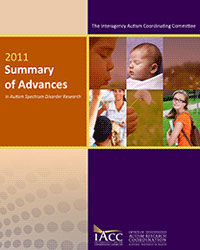Summary of Advances
In Autism Spectrum Disorder Research
2011
Trends in the prevalence of developmental disabilities in US children 1997-2008 – Boyle C, Boulet S, Schieve LA, Cohen RA, Blumberg SJ, Yeagrin-Allsopp M, Visser S, Kogan MD. Pediatrics. 2011 Jun;127(6):1034-42. [PMID: 21606152]
Developmental disorders among children in the U.S. increased in prevalence by 17.1 percent from 1997 to 2008, affecting an estimated 1.8 million more children than a decade before. Of all developmental disorders, autism showed the most growth, increasing 289 percent over the twelve-year time frame. During the same period, attention deficit hyperactivity disorder (ADHD) increased by 33 percent, while moderate to profound hearing loss, the only developmental disability to show improvement, decreased by 30.9 percent. In total, 15 percent of all children in the U.S. had some sort of developmental disability when last measured in 2008. Boys were more likely than girls to have a developmental disability and Hispanic children had a lower prevalence than other racial groups. The prevalence of developmental disabilities increased in all groups regardless of race or socio-economic status. Children from low-income families were more likely to have a developmental disability and those on Medicaid were nearly twice as likely to have a diagnosis. The study, conducted by the Centers for Disease Control and Prevention, analyzes data from 119,367 children ages 3 to 17 collected during National Health Survey Interviews. Parents or legal guardians were asked if their children had any of the following conditions: ADHD, autism, blindness, cerebral palsy, moderate to profound hearing loss, intellectual disability, learning disorders, seizures, stuttering/stammering, or any other developmental delay. The study authors conclude that the increased prevalence of developmental disorders demonstrated by the study underscores the heightened need for targeted health, education, and social services.
Prevalence of autism spectrum disorders in a total population sample – Kim YS, Leventhal BL, Koh YJ, Fombonne E, Laska E, Lim EC, Cheon KA, Kim SJ, Kim YK, Lee H, Song DH, Grinker RR. Am J Psychiatry. 2011 Sep;168(9):904-12. [PMID: 21558103]
A comprehensive study of school children in a region of South Korea revealed that approximately 1 in 38 children, or 2.6 percent, are on the autism spectrum. This study was the first of its kind to use total population sampling, and the findings suggest that using this technique might increase prevalence estimates in other countries. Researchers assessed more than 55,000 children between the ages of 5 and 12 living in the middle-class city of Goyang and found that two-thirds of the students with ASD were undiagnosed and had never received services. Only one third of the students with ASD were in the study's "high probability group" of 294 children enrolled in special education or listed on a disability registry. The rest of the children diagnosed with ASD were among the general population enrolled in mainstream classrooms. The authors note that if only the high probability group had been used to calculate prevalence, they would have arrived at a 0.7 percent prevalence rate – similar to the 0.9 percent in the United States. They hypothesize that the low level of awareness about autism and the high degree of stigma surrounding the disorder in South Korea could partially explain the large number of undiagnosed children. To identify autism among children enrolled in mainstream classrooms, researchers asked parents and teachers to complete a 27-item questionnaire – children who screened positive for autism on the assessment were individually evaluated using gold-standard diagnostic methods. The study findings suggest that total population studies may be necessary to produce more accurate ASD prevalence estimates. Further work will need to be done to determine whether the South Korean findings can be generalized to other countries.




